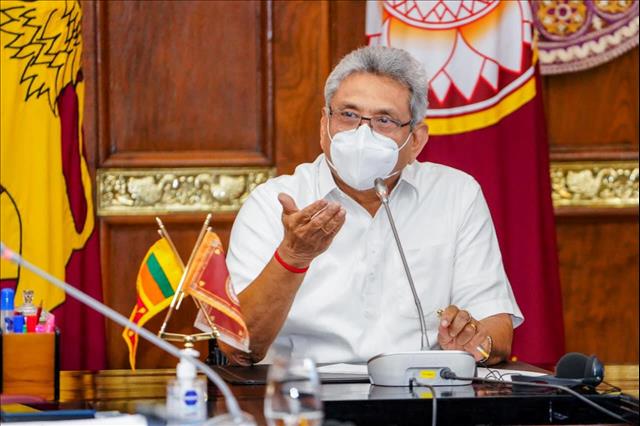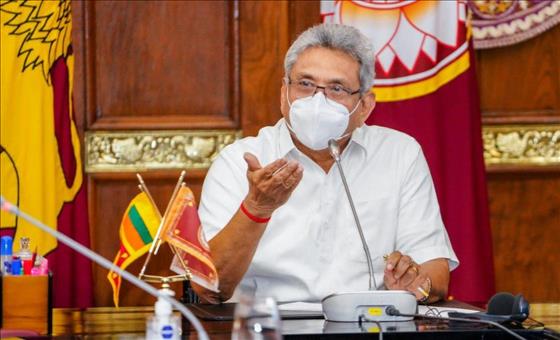
Sri Lanka- Rebalancing international politics and internal economics
(MENAFN- Colombo Gazette) 
By N Sathiya Moorthy
Even as President Gotabhaya Rajapaksa has begun addressing the post-covid economic recovery plans with the Task Force appointed by him, thee is an urgent need for the Government to consider domestic options thatfor the individual should be the underlying factor, not attracting foreign investments if it is not going to address these two issues.
Addressing the President's Economic Task Force, incumbent President Gotabhaya Rajapaksa has advised them to look at nations unaffected by coronavirus for attracting tourist. It rings similar to the successful efforts of Sri Lanka and neighbouring Maldives to attract tourists from new and untapped markets, when the West was caught under the 'global economic melt-down'. Thus was discovered the huge Chinese market and the untapped Indian market, among others.
For the two South Asian neighbours, international tourism was a major component of their economy. They were recovering from the tsunami- shocks of December 2004, when the melt-down occurred. It is immaterial if it was as 'global' as being made out to be, implying the West (alone) constituted the globe. At best it was like the West dubbing and describing the South-East Asian fiscal crisis a decade earlier as the 'Asian fiscal crisis'.
In downsizing their tourism target-markets during the melt-down, Sri Lanka, and also Maldives, thought out of the box, and found new sources for their own economic recovery. President Gotabhaya seems telling his Task Force to think out-of-the-box once again, and come up with a solution. There is a problem, there, not that it cannot be overcome.
Unlike during the melt-down or even tsunami, today, Sri Lanka is as much a pandemic-hit nation as any of its traditional tourist-exporting nation. Given their own uppity assessment of the self against the 'other', the Government can convince those tourists, especially tourist operators in those countries, if and only if it can prove to their entire satisfaction that Sri Lanka, too, is pandemic-free.
From the hotel footman to door-knobs, cabbies and their cabs, bars and restaurants, all will remain suspect in the eyes of a visitor, for a long, long time to come. International flights, barring possibly those chartered ones from Europe and elsewhere, luggage-handlers at Kattanayake and every man and woman on Sri Lankan streets would then have to carry a medical certificate hanging from his/her neck or written all across his/her forehead, that he or she is 'covid free'.
This is an issue that the Task Force would have to grabble with, but in consultation with Health officials and the rest. Yet, such a kind of confidence-building is not going to happen, even if they are all able to undertake a road-show in 'untapped countries' from now on, to be able to attract more tourists. One possible way may be for promoting a combined 'South Asia package', which again depends on the mood and method of individual nations. More importantly, they too have to be declared covid-free.
Political stability
This government did not create the economic crisis, it inherited the same, instead. Covid might have come in the way of economic recovery, whoever was in power, hence the Government cannot blame it all on the pandemic. It cannot go the same way as the predecessors, who blamed the economic crisis of their times on the previous war-victor of another Rajapaksa regime, but did nothing about it.
They did not have time for the same even if some of them may (or, may not) have had certain ideas. They were busy fighting themselves, fighting shadow-boxing even within the mainstay UNP, only power glued them together. Now, in the Opposition, the subterranean currents of the past decades has finally come out in the open.
The voter brought back the Rajapaksas, this time in the name of President Gotabhaya last November, only because of their 'tough act' and the kind of political stability that they represented during brother Mahinda Rajapaksa's ten long years in office. Yes, the economy continued to falter, owing to the war and post-war political attention being drawn away to distant Geneva and the UNHRC.
To the average Sri Lankan voter, money in the pocket matters the most than 'nationalism' of any kind. A whole new generation of voters, though not born post-war, grew up without war and much of the violence confined to the North and some in the East earlier, away from his own eyes and psyche. They often outnumber the older generation whose memories too keeps fading faster than expected – and is accepted.
Import substitution
The bane of the UNP brand of 'market economy' was that it provided only for privatisation and massive imports, without actually attracting the kind of foreign investments it supposedly promised. With that went the dream of creating more jobs in the non-traditional sector, even as their policies literally killed traditional sectors like agriculture and dairy – the latter in particular.
The left-leaning SLFP which returned to power, post-JRJ, in the nineties under CBK was more 'liberal' on the economic front than even the rival UNP fathers. The Rajapaksas who succeeded CBK had their priorities cut out for them. Their brand of 'nationalism' did not include 'economic nationalism' then, it cannot but do so now – to a limited extent, that is.
Sri Lanka needs forex and forex reserves, yes. It can be attracted only by boosting foreign investments. It should be done for and through a national quid pro quo. Job-creation and revenue-generation for the Sri Lankan State are the two factors.
It need not mean that like neighbouring Maldives, the Government has to palm of Sri Lankan real-estate (read: territory and by extension sovereignty) to the first sighted guy with a money-bag. It need to stop with, and only with facilitating early clearances, facilitating early setting up of new industries faster, without tying them to red-tape of the Third World kind.
Import-substitution should otherwise be the name of the game. It does come with banning essentials or taxing imported goods heavily. Such a latter strategy may have increased the Government's revenues from import duties and other levies, it may have also fattened the pocket of some favourite importers of the Government of the day, but it is not going to make things easier for a cash-strapped people.
Managing this situation imaginatively, over the short and medium-terms is a must. There are no quick answers. One way, for instance, is to try and revive the agriculture and dairy sectors, among others, as there is a preceding requirement to find out if the post-reforms youth in the country want to dirty their hands, and know how to do it in the farmer's way, without getting hurt (financially), as their grand-parental generation and those before them had done. But the scope for such revival cannot be ruled out, without a closer look.
Hambantota model
As Prime Minister Mahinda Rajapaksa told the all-party ex-MPs' meeting, no foreign aid has actually landed with the Government. He also said that the promised IMF package was also yet to be delivered. Subsequent news reports have indicated that negotiations with the IMF were underway.
Going by past experience, IMF negotiators are tough on trimming national policies and budgets to their standards, which have been failing even their favourite West, time and again. The Sri Lankan alternative just now is China, which alone seems to be having all the money in the world, and is not unwilling to put it where it may or may not give that nation economic returns.
It is as yet unclear what China expects to achieve from the Hambantota kind of investments over the medium and long terms. Short-term, they have not show up fiscal profits. If it was the kind of 'swap deal' of the Hambantota kind that alone China was looking for, it has got one, or more, at least in Sri Lanka.
Post-covid, China offered $ 500 m to Sri Lanka to shore up the dwindling forex in March, and promised another $ 700 m for this month. Helpful as they are, in these years after Mahinda Rajapaksa's presidential poll-defeat in 2015, the incumbent Government cannot hope to repeat the same, without public revulsion and possible protests on the streets.
Such protests, if it came to that, could well be more serious than those that stood outside President Mahinda R's 'Temple Trees' residence in capital Colombo, stalling the India CEPA in 2008. More recently, when the Sirisena-Wickremesinghe duo regime was negotiating Indian participation in the utilisation of the Chinese white elephant of the Mattale airport, Namal Rajapaksa, MP, led the protestors, until pulled out by father Mahinda R.
Interestingly, there seems to be a 'national consensus' (?) of an inexplicable kind, not only on market capitalism, but also on the India-China front, even more, and even more recently. Like Mahinda and the CEPA, Ranil Wickremesinghe offered words and promises alone to India, but never ever came anywhere close to signing the CEPA-replacement in an ETCA. Better still, he lent greater legitimacy to the Hambantota deal.
With the 'swap deal' on Hambantota, West-oriented Wickremesinghe personally laid the foundations for China's permanent presence here more than already, He blamed it on the Rajapaksa-laid 'debt-trap', but even before the swap-deal ink dried, he went ahead and borrowed $ 100 m (no small amount, this) for laying more express ways, through no trade-transit worth the name was likely to happen in decades.
All this, even as both the Rajapaksas and the Ranils of the world seemingly took great pains to scuttle/bury the India-offered export-oriented Pharma SEZ in Trincomallee, with potential to great jobs for locals, and incomes for their families, local industry and the State of Sri Lanka. The list of such calculated scuttling of Indian and other third-nation offers from within the Sri Lankan State, and by the Sri Lankan State are too numerous to be listed.
If nothing else, cost of importing say medicines from Indian neighbour is cheaper in every sense of the term, including transportation costs, when compared to continuing with the colonial era practices of getting them all from distant Europe, with patently higher mark-ups, which can kill an average Sri Lankan in financial terms, as it may (also) save his life.
Today, India, for instance, is a global pharma major, as much as it is a political power in its own right. But the continuing Sri Lankan political and politicised habit can only make a Chinese colony of the nation, in parts, if not as a whole, in the post-covid era. This includes the recent Chinese 'commitment' to help Sri Lankan economy recover fast. It can create more problems for the Sri Lankan State and leadership nearer home than in the JVP past, only that the authorities may not even know where from the nation's under-belly such a 21st revival could evolve.
(The writer is Distinguished Fellow and Head-Chennai Initiative, Observer Research Foundation, the multi-disciplinary Indian public-policy Indian think-tank, headquartered in New Delhi. Email: [email protected] )

Legal Disclaimer:
MENAFN provides the
information “as is” without warranty of any kind. We do not accept
any responsibility or liability for the accuracy, content, images,
videos, licenses, completeness, legality, or reliability of the information
contained in this article. If you have any complaints or copyright
issues related to this article, kindly contact the provider above.


















Comments
No comment